
OUR VERDICT
The Surface Studio is a most impressive desktop that has already shaken up the all-in-one PC landscape, however, its exorbitant price makes it an extravagant dream for everyone but artists and illustrators.
FOR
- Seamlessly transitions between modes
- The best and biggest digital drawing board
- Impeccable build quality
AGAINST
- All rearward ports
- Pricey proposition for most
While the high cost of entry might have turned you off at launch, the Surface Studio has created a niche for itself among professionals and creatives alike. For anyone reluctant to take the plunge into an all-in-one PC running full-fat Windows 10, the Surface Studio tries to convince enterprise users and IT professionals alike by allowing them to use custom scripts while updating.
If the idea of competent software doesn’t seem too exciting, we don’t blame you, but you’ll be happy to know that there’s a lot beneath the surface. It combines the speedy performance of the best PCs with the inherent flexibility of the best 2-in-1 laptops. Yeah, it’s not going to be the first touchscreen desktop, but it’s the first one we’ve used that can turn into a virtual drafting table, thanks to its Zero Gravity Hinge. The hockey puck-like Surface Dial can also go a long way to set the Surface Studio apart from the pack, as well.
It can’t be denied that the Surface Studio is an expensive PC, which could turn you away. For instance, the closest competition starts at around half the price for close to or better hardware. So, until the Surface Studio 2 comes out, this Surface Studio review should help you figure out if the flexibility and accessorization is worth the price of admission. For everyday users, it might not be.
Pricing and availability
Microsoft’s Surface devices are usually aimed at a premium market, but the Surface Studio takes to a whole new level, starting at $2,999 or AU$4,699 (about £2,390). All versions of this all-in-one PC (AIO) come with a 28-inch (4,500 x 3,000) display. But, at this level, you’ll be getting an Intel Core i5 processor with 8GB of RAM, 1TB hard drive (with an integrated 64GB SSD) and Nvidia GTX 965 (2GB GDDR5 VRAM) graphics.
The Surface Studio ranges from anywhere between $2,999 (£2,999, AU$4,699) and $4,199 (£4,249, AU$6,599), the latter of which we reviewed here.
The ‘cheapest’ unit comes outfitted with a 6th-generation Intel Core i5 processor, 8GB of RAM, a 2GB Nvidia GeForce GTX 965M GPU and 1TB of storage. Meanwhile, if you want to max out the Surface Studio you’ll get an Intel Core i7 processor, 32GB of RAM and a 4GB GTX 980M eGPU.
A total of $4,199 (£4,249, AU$6,599) is a frightening price tag, particularly when you can pick up an HP Z1 G3 for just $1,359 (about £971, AU$1,723) featuring a business-class Intel Xeon E3-1270 CPU, Nvidia Quadro M2000M graphics and a 3,840 x 2,160 4K screen to top it all off. Plus, unlike the Surface Studio before it, HP’s workstation all-in-one is easily upgradeable and future-proof thanks to internal accessibility.
The Surface Studio reviewed here is an expensive desktop, to be sure. Even if you were to max out the Dell XPS 27 AIO, it wouldn’t even come close at $3,299 or £2,999 (about AU$4,320). Similarly, the HP Envy AIO 27 maxes out at just $1,799 (about £1,346, AU$2,363).
Luckily, there will be a ton of Black Friday and Cyber Monday deals that will make the price of the Surface Studio more palatable. We think there’s a pretty good chance that retailers will want to clear out some stock now that the Surface Studio 2 is almost here.
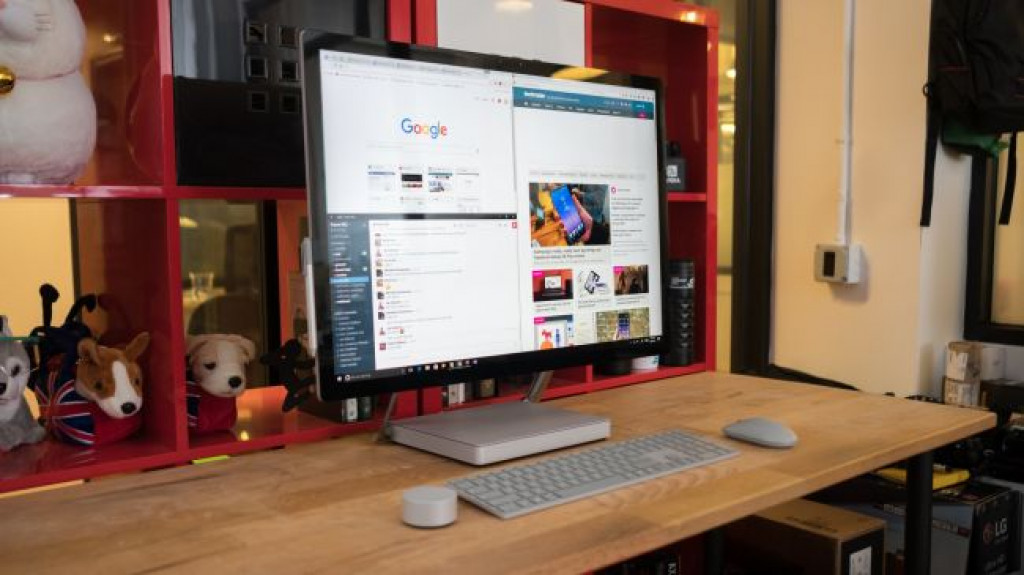
Design
From the moment we pulled the Surface Studio out of its box, we knew we were in love.
There isn’t any shortage of impressive desktops what with Apple’s ever-thinning iMacs to the six-speaker sound on Dell’s XPS 27 AIO. Still, nothing comes close to the elegance and simplicity offered by the Surface Studio.
By transferring all the components to the base, the display is just a touchscreen with remarkably thin bezels. Without that rear bulk, the profile of the screen is just 12.5mm, making it slimmer than even the best monitors.

There’s also no fat chin underneath the screen to flaunt a Windows logo – actually, it’s refreshing to see no branding anywhere except for a mirrored logo on the back.
The Surface Studio is a modern and minimalistic desktop designed with straight edges and a simple gray on chrome aesthetic. The base of the desktop takes this one step farther by simply being a nearly featureless, ashen box. The noticeable element is a subtle line that wraps around the perimeter of the Studio’s foundation to provide cooling for the mobile computing parts contained within.
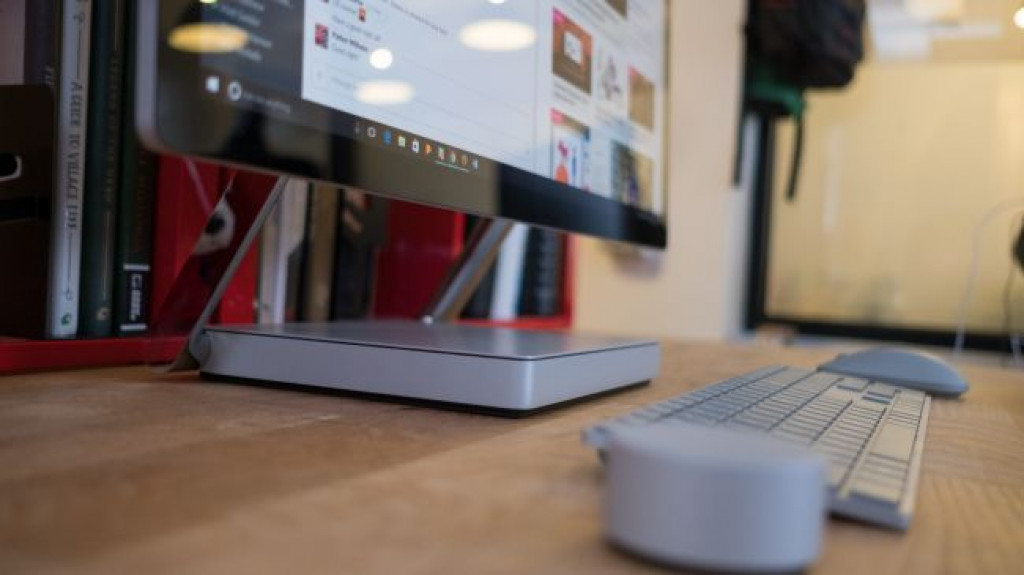
Microsoft arguably takes this clean aesthetic a bit too far, as all the USB 3.0 ports as well as the memory card reader are located on the rear. The lack of USB-C and ThunderBolt also means you won’t be able to take advantage of the fastest external drives.
Although we’ve already said our piece on the Surface Keyboard and Surface Mouse separately, we absolutely adored the completely wireless and clutter free setup when paired with the Surface Studio.
The two come included along with a Surface Pen in the box, though you might soon find that it’s not the best version of the accessory you can buy. With Microsoft having patented a new rendition of the Surface Pen, complete with haptic feedback capabilities, the experience of using the stylus accessory might resonate even more with us in the future.
Back to the digital drawing board
We’ve seen some truly impressive displays, such as the 5K iMac and Dell’s ridiculous 8K monitor, but the Surface Studio takes the cake.
Even though 4,500 x 3,000 pixels isn’t the sharpest resolution in the world, it’s sharper than a 4K display without being overbearing. This combination of screen resolution and size with the Surface Studio’s unique 3:2 aspect ratio means you can snap four separate programs to each corner and still have a legible view of each app. Frankly, the size and resolution just work.
Microsoft’s nearly perfect sense of color gamut and contrast carries over to its latest PixelSense display. Additionally, there are more color profiles to choose from, including sRGB, Vivid, and DCI-P3 to make it a truly production-grade display.
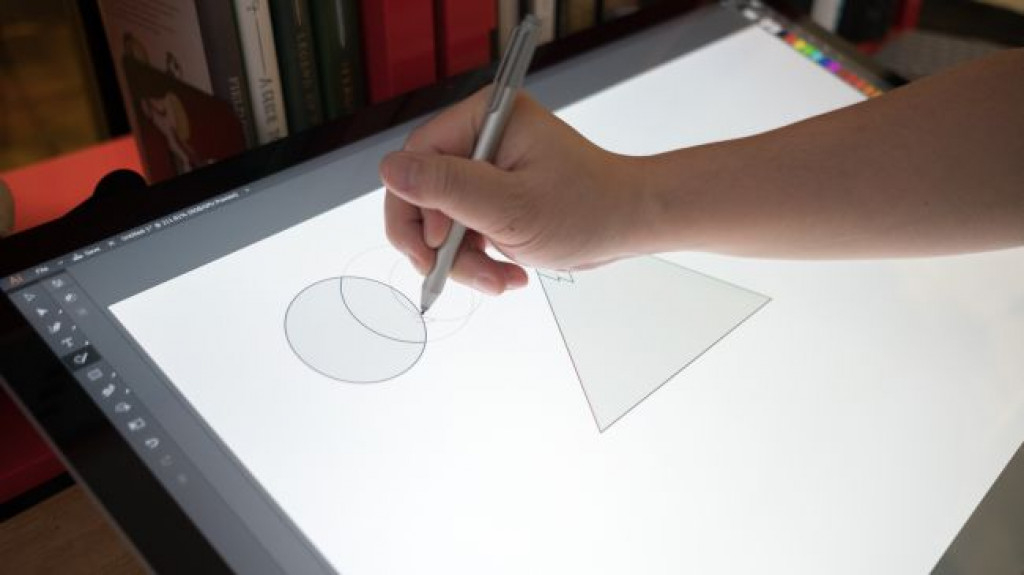
Holding up this glorious display is the Surface Studio’s other winning feature, the Zero Gravity Hinge. This catchy-named mechanism absorbs all the torque required to move the 13-pound display, making it easy to switch from a standard all-in-one PC to a digital drawing surface.
When lowered, the touchscreen on the Surface Studio holds itself at the same angle of pitch as a standard drafting table. Of course, you can also adjust the display at different levels of tilt and without worrying about it moving under the weight of your hands as you work.
Like the Surface Book and the Surface Pro 4, drawing and writing on the Surface Studio feels almost too good to be true. Surface Pen strokes translate perfectly into lines of digital ink. Unlike other styluses that feel like they’re gliding on glass or cutting themselves into the touchscreen, Microsoft has refined tis hardware so that it offers the right amount of resistance.
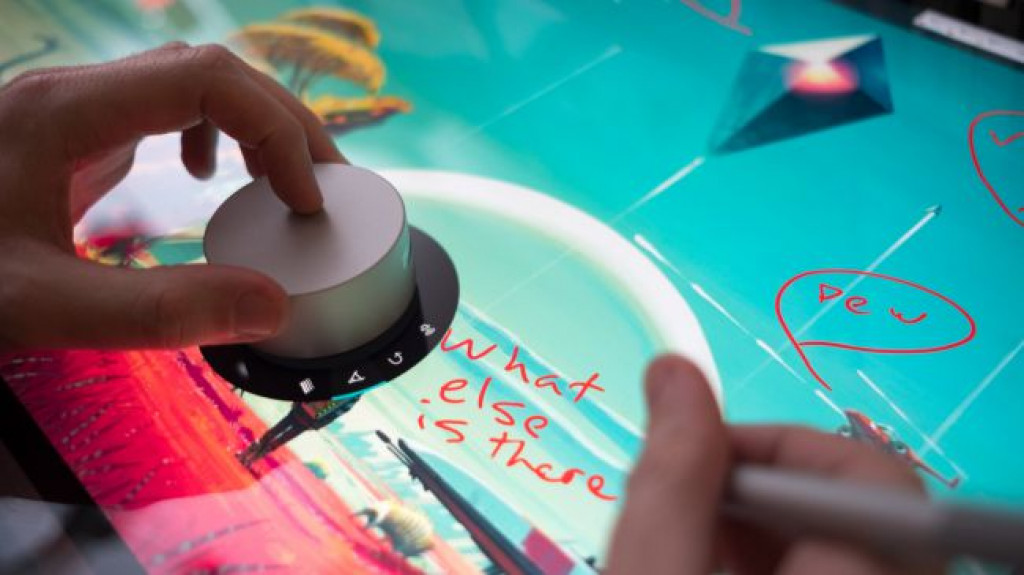
Dialing it in
Using Bluetooth to wirelessly tether it to the Surface Studio, the newly introduced Surface Dial is a creation unique to Microsoft. Shaped much like a hockey puck, the Surface Dial has the potential to be a game-changer for creative professionals who also have a proclivity for Windows 10, a common demographic for the Redmond tech giant’s recent products.
The Surface Dial is intuitive, and within minutes of picking it up, you’ll realize it both spins and acts as a physical button. Pushing in the dial will bring up a radial menu of options like volume and screen brightness controls as well as zooming and scrolling. Hit it again, and you’ll be able to tweak whatever option you chose.
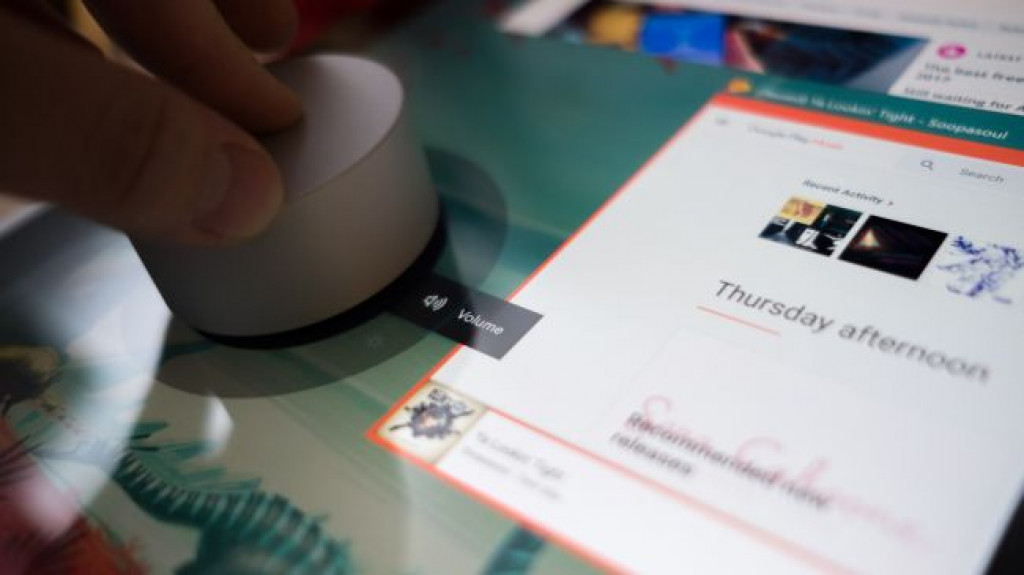
But that’s not where the utility of this peripheral starts and ends. Instead, the Surface Dial is compatible with a wide array of apps that have been optimized in its favor. These include both first- and third-party applications, such as Adobe Photoshop and Illustrator, Microsoft Photos and even Spotify.
In the Adobe Creative Cloud software specifically, users can leverage the power of the Surface Dial by rotating it in order to tweak brush settings in addition to adjusting for size, opacity, hardness, flow and smoothing. In Spotify, on the other hand, the music volume can be changed in by the force of a simple hand motion.
It might sound functionally simple, but having that quick access to physical controls without having to stop drawing is huge if you want to stay absorbed in your process. Of course, this also means only digital artists and other creative professionals are going to get the most out of this accessory.

One other small gripe we have with the Surface Dial is it doesn’t stay in place when you have it on the Studio’s screen. Instead, it slowly slides down the touchscreen – even if it’s lowered all the way.
After installing the Creators Update, we were able to squeeze a bit more functionality out of the Surface Dial. The more recent versions of Windows 10 integrate customizable Dial controls and Paint3D as another app for the artistically adept.
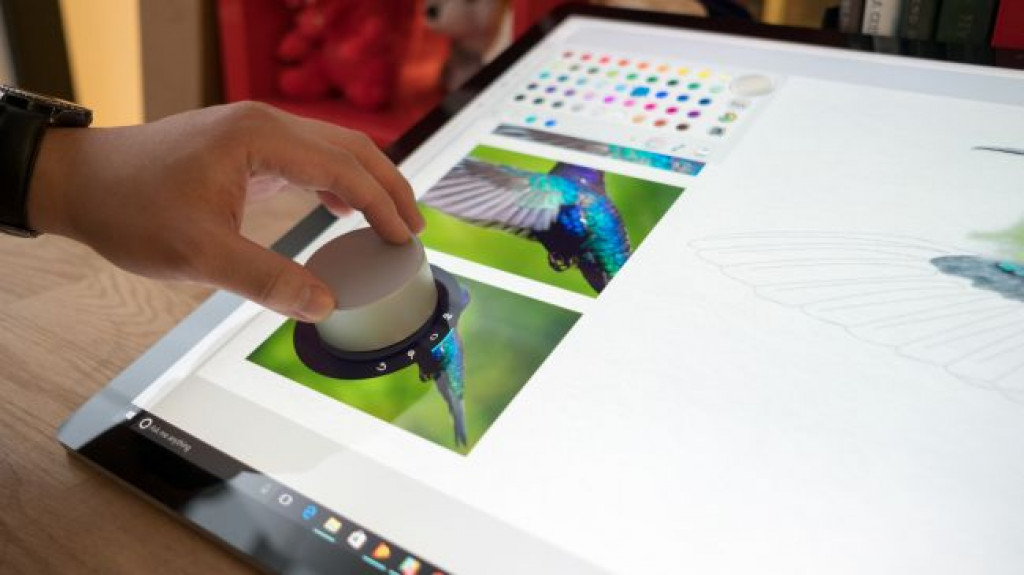
Performance
You might balk at the graphics chip from last year and the less-than-current Skylake processor on its spec sheet, but the Surface Studio keeps up with other all-in-one machines.
Thanks to the high-end graphics chip here, the Surface Studio pulls well ahead of the XPS 27 AIO and iMac with 5K Retina screen with a Fire Strike score that’s almost four times higher. Unfortunately, the Surface Studio’s processing power doesn’t prove to be as impressive, and its more CPU-intensive benchmarks scores fall behind.
Benchmarks aside, this desktop knows how to put in work. Microsoft’s AIO never buckled, even as we loaded up dozens of tabs on two web browsers, a separate Google Music streaming app, Slack, Adobe Photoshop and Illustrator all at the same time. Even Lightroom, which usually grinds gaming laptops to a halt, ran smoothly on the Studio as we processed images for this review.
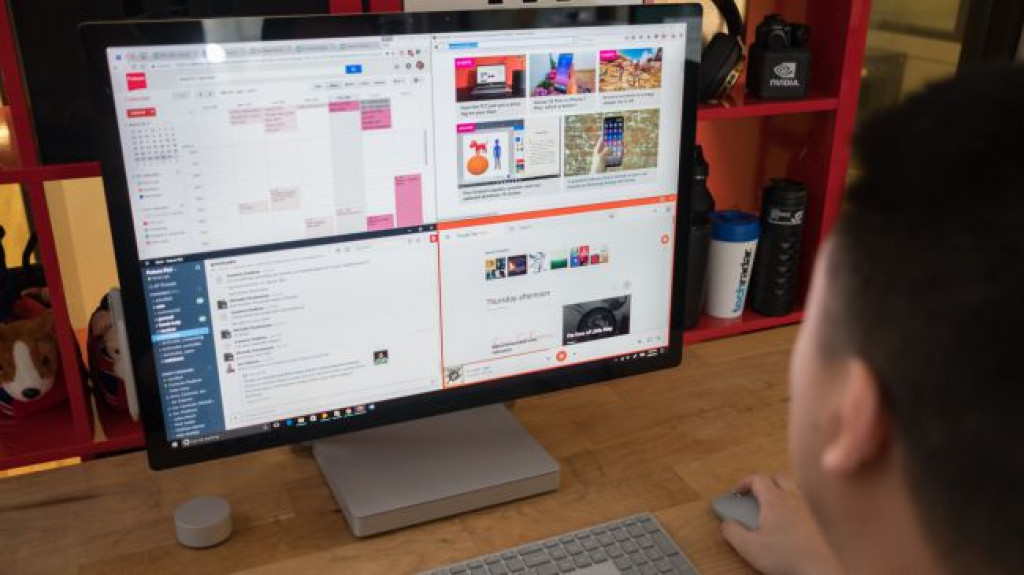
We also played a fair number of Overwatch matches at the Surface Studio’s full-screen resolution with Ultra settings without issue. During our entire time with the device, we didn’t encounter any graphical performance issues that would have required the latest Nvidia graphics.
The most impressive thing about the Surface Studio’s performance is how quickly everything loaded on it. Rather than being equipped with a traditional SSD or hard drive, Microsoft used Intel’s Rapid Storage Technology to intrinsically tie a 2TB spinning drive to 128GB of flash memory.
In this setup, the hard drive does all the heavy lifting of storing all your files, meanwhile, a smaller segment of your data is compartmentalized onto the SSD if it has been associated with a commonly used program or service. Although this system doesn’t allow you to directly access the faster storage solution, we never felt like we had too as files loaded seamlessly and quickly the whole time.
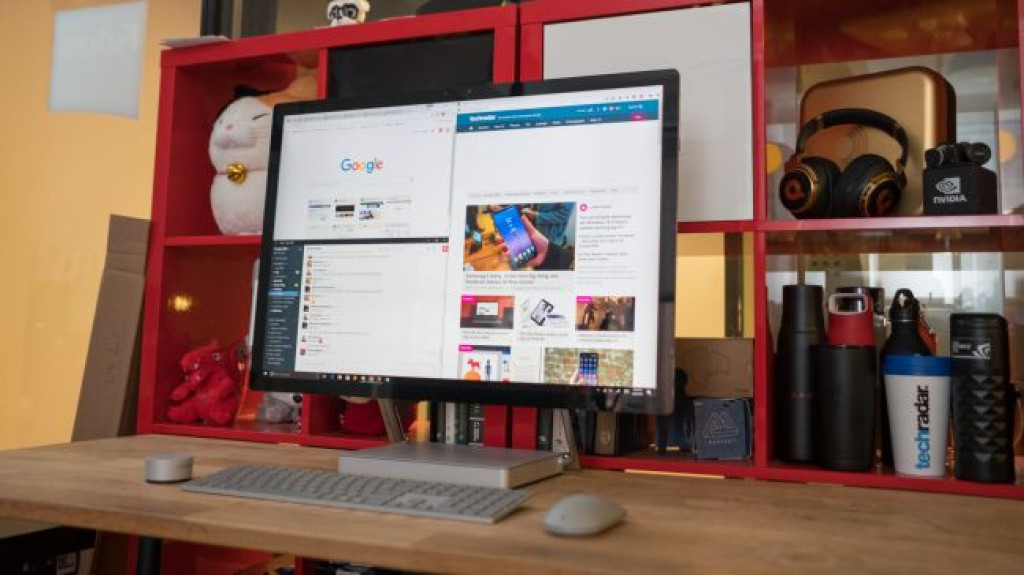
Final verdict
We hesitate to say that if you weren’t interested in the Surface Studio already, our review probably didn’t change your mind. Microsoft’s contribution to the all-in-one PC space is expensive to say the least, but it’s also nothing short of the best when it comes down to build quality and innovation beyond offering the latest specs.
Whereas the iMac, Dell XPS 27 AIO and HP Envy 27 AIO are all compelling additions to the market, the Surface Studio thrives because of its uncompromising desire to convince you that it’s something else entirely. For the price of a Surface Studio, sure, you could build a PC that’s just as powerful and still have money left over.
However, for artists and especially illustrators the Surface Studio introduces a new wrinkle into a world primarily dominated by Wacom tablets. Not only does the Surface Studio allow you to sketch and inspect your picture with one device, the visual quality of the PixelSense display is far greater than that of Wacom’s Cintiq display or Dell’s new 27-inch Canvas.
For these reasons we’ll say it again – the Surface Studio best serves artists and illustrators. It’s without a doubt one of the best computers ever produced, but there’s no reason regular users should purchase this unless they’re in the market for the highest end iMac and want more options – or bragging rights.
Source: techradar.com









































